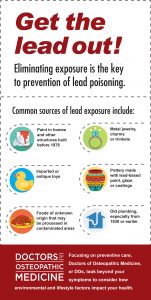Lead Poisoning: What Parents Need to Know
Although lead poisoning may occur at any age, it can be particularly damaging for children under age 6. According to Kathleen J. Vedock, DO, an osteopathic pediatrician, kids are more susceptible to the dangers of lead because their intestinal tracts absorb more than those of adults and their developing brains are more sensitive.
Focusing on preventive care, Doctors of Osteopathic Medicine, or DOs, look beyond your symptoms to consider how environmental and lifestyle factors impact your health. By taking a whole-person approach to care, DOs are trained to address issues such as lead poisoning that can silently, but drastically affect your health.
Lead poisoning among children can lead to long-lasting health problems, including:
- ADHD
- Learning difficulties
- Hearing loss
- Fatigue
- Abdominal pain and constipation
Sources of Lead Exposure
Although treatment is available for lead poisoning, there is no cure. “It’s important to identify any environmental exposure to lead,” says Dr. Vedock. “Eliminating exposure is the single best prevention method to keep you and your family safe.”
Because lead is odorless, tasteless, and and nearly impossible to see, it is important to know where lead can be found. Potential sources include:
- Homes and other structures built before 1978 that contain lead-based paint, which may produce lead dust that can be ingested through swallowing or breathing
- Water pipes
- Imported antique toys
- Metal jewelry or trinkets
- Imported foods
- Clay pots
7 Ways to Lower Your Risk
Lead poisoning risk varies based on geographical and socioeconomic factors, but families can take the following steps to help limit exposure:
- Test soil, paint, dust, and water in and around your home for lead.
- Regularly wash children’s hands and toys.
- Keep floors, windowsills and other dusty surfaces clean.
- Remove shoes that may contain lead-contaminated soil when entering the home.
- If you live in a home with older plumbing that may contain lead pipes, run cold water for at least one minute before using.
- Eat a diet rich in calcium and iron, which can help lower lead absorption in children.
- Take extra precautions if completing construction in a home with lead-based paint. Do not sand painted surfaces or eat and drink in an area where lead dust may be found.
“If you suspect your child has been exposed to lead, talk to your doctor about ordering a simple blood test,” says Dr. Vedock.

